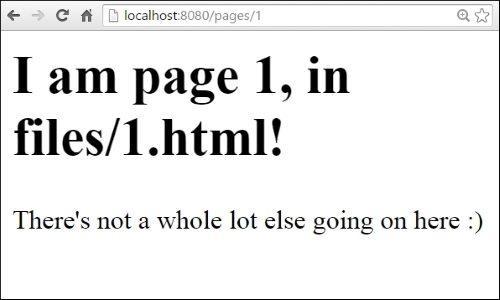In the previous session, we looked at basic routing but that can only take us so far, we have to explicitly define our endpoints and then assign them to handlers. What happens if we have a wildcard or a variable in our URL? This is an absolutely essential part of the Web and any serious web server.
To invoke a very simple example, consider hosting a blog with unique identifiers for each blog entry. This could be a numeric ID representing a database ID entry or a text-based globally unique identifier, such as my-first-block-entry.
Note
In the preceding example, we want to route a URL like /pages/1 to a filename called 1.html. Alternately, in a database-based scenario, we'd want to use /pages/1 or /pages/hello-world to map to a database entry with a GUID of 1 or hello-world, respectively. To do this we either need to include an exhaustive list of possible endpoints, which is extremely wasteful, or implement wildcards, ideally through regular expressions.
In either case, we'd like to be able to utilize the value from the URL directly within our application. This is simple with URL parameters from GET or POST. We can extract those simply, but they aren't particularly elegant in terms of clean, hierarchical or descriptive URLs that are often necessary for search engine optimization purposes.
The built-in net/http routing system is, perhaps by design, relatively simple. To get anything more complicated out of the values in any given request, we either need to extend the routing capabilities or use a package that has done this.
In the few years that Go has been publicly available and the community has been growing, a number of web frameworks have popped up. We'll talk about these in a little more depth as we continue the book, but one in particular is well-received and very useful: the Gorilla web toolkit.
As the name implies, Gorilla is less of a framework and more of a set of very useful tools that are generally bundled in frameworks. Specifically, Gorilla contains:
gorilla/context: This is a package for creating a globally-accessible variable from the request. It's useful for sharing a value from the URL without repeating the code to access it across your application.gorilla/rpc: This implements RPC-JSON, which is a system for remote code services and communication without implementing specific protocols. This relies on the JSON format to define the intentions of any request.gorilla/schema: This is a package that allows simple packing of form variables into astruct, which is an otherwise cumbersome process.gorilla/securecookie: This, unsurprisingly, implements authenticated and encrypted cookies for your application.gorilla/sessions: Similar to cookies, this provides unique, long-term, and repeatable data stores by utilizing a file-based and/or cookie-based session system.gorilla/mux: This is intended to create flexible routes that allow regular expressions to dictate available variables for routers.- The last package is the one we're most interested in here, and it comes with a related package called
gorilla/reverse, which essentially allows you to reverse the process of creating regular expression-based muxes. We will cover that topic in detail in the later section.
Note
You can grab individual Gorilla packages by their GitHub location with a go get. For example, to get the mux package, going to github.com/gorilla/mux will suffice and bring the package into your GOPATH. For the locations of the other packages (they're fairly self-explanatory), visit http://www.gorillatoolkit.org/
Let's dive-in and take a look at how to create a route that's flexible and uses a regular expression to pass a parameter to our handler:
package main import ( "github.com/gorilla/mux" "net/http" ) const ( PORT = ":8080" )
This should look familiar to our last code with the exception of the Gorilla package import:
func pageHandler(w http.ResponseWriter, r *http.Request) {
vars := mux.Vars(r)
pageID := vars["id"]
fileName := "files/" + pageID + ".html"
http.ServeFile(w,r,fileName)
}Here, we've created a route handler to accept the response. The thing to be noted here is the use of mux.Vars, which is a method that will look for query string variables from the http.Request and parse them into a map. The values will then be accessible by referencing the result by key, in this case id, which we'll cover in the next section.
func main() {
rtr := mux.NewRouter()
rtr.HandleFunc("/pages/{id:[0-9]+}",pageHandler)
http.Handle("/",rtr)
http.ListenAndServe(PORT,nil)
}Here, we can see a (very basic) regular expression in the handler. We're assigning any number of digits after /pages/ to a parameter named id in {id:[0-9]+}; this is the value we pluck out in pageHandler.
A simpler version that shows how this can be used to delineate separate pages can be seen by adding a couple of dummy endpoints:
func main() {
rtr := mux.NewRouter()
rtr.HandleFunc("/pages/{id:[0-9]+}", pageHandler)
rtr.HandleFunc("/homepage", pageHandler)
rtr.HandleFunc("/contact", pageHandler)
http.Handle("/", rtr)
http.ListenAndServe(PORT, nil)
}When we visit a URL that matches this pattern, our pageHandler attempts to find the page in the files/ subdirectory and returns that file directly.
A response to /pages/1 would look like this:

At this point, you might already be asking, but what if we don't have the requested page? Or, what happens if we've moved that location? This brings us to two important mechanisms in web serving—returning error responses and, as part of that, potentially redirecting requests that have moved or have other interesting properties that need to be reported back to the end users.
